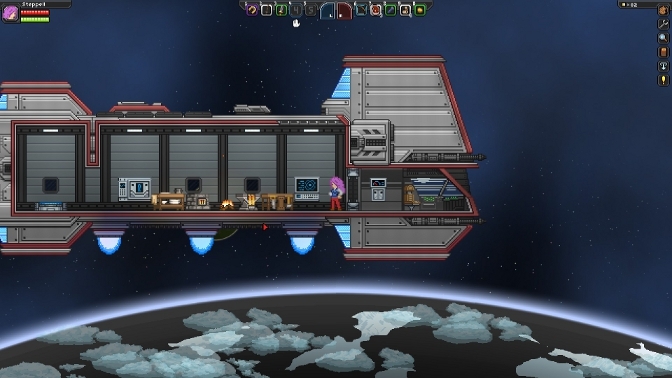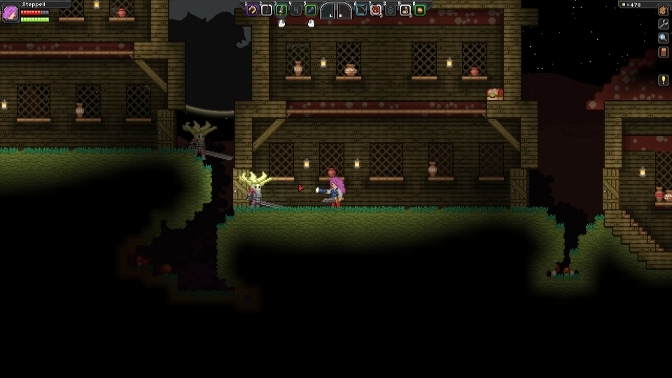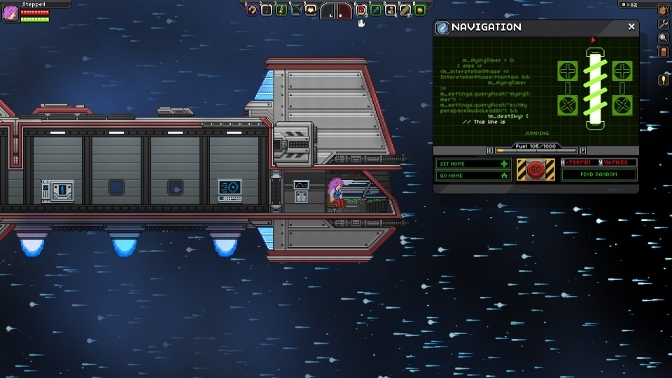I – Prediction
I bought Chucklefish’s Starbound a year or so ago. I don’t usually purchase Early Access games on Steam (I have a copy of Towns in my library), but, like so many others who’d fallen in love with Minecraft and then its gamier 2D cousin Terraria, I really bought into the hype for Starbound. I’d heard the rumours, I’d watched the trailers, and I really wanted to build houses and fight monsters on the planet of the eyeball trees and others.
So shortly after making my purchase, I started the game up and was immediately impressed by the myriad complexities it presented right off the bat. When creating a character, you could choose from a whole bunch of alien races (plus boring humans) and in general create a much more varied type of player character than was possible in Terraria. Once that was done and the game began, you found your new character aboard a spaceship, and were immediately presented by quests and journals and 3D printers and all sorts of crafting and customisation. And then you could beam down to the planet below.
The first planet I landed on was a nice grassy one with lots of trees, very reminiscient of Terraria. But then I found all sorts of strange alien monsters, existing well-furnished houses and even mines and alien characters who spoke to me in gibberish. At first brush, this game seemed like everything I’d wanted and more. My only immediate gripe was that I couldn’t change the controls, and the jump action was mapped to the spacebar instead of Up/W (as is my preference in platformers).
I didn’t play much more of Starbound immediately because of a variety of reasons – the academic year had begun, and organising multiplayer sessions (the most fun way to play Terraria and ergo, I reasoned, the most fun way to play Starbound) would have been tricky with everyone’s various commitments. That, and the first time I did try to play the game with some friends we spent a good half-hour trying to figure out how to get from our separate spaceships to each others’ planets. But I didn’t have any particularly negative thoughts about Starbound; I merely acknowledged that I didn’t currently have time to play it and enjoy its no-doubt endless depth and complexity, and would find time to do so later on.
Later on turned out to be just this week, as I was setting up my new PC and moving over all my various files, including Steam games. After the prerequisite fancy-new-PC ritual of starting up all my AAA games and turning their graphics settings all the way up,1 I happened upon Starbound sitting dusty and forgotten in my Steam library and decided to give it another go. The ability to remap controls had still not been implemented, but I pressed on with the spacebar.
A few hours later, I realised why I hadn’t made any effort to play much of it since that first time. Starbound, although it looks and plays like a massively extended version of Terraria, misses some key elements of what makes that game work.

Terraria, the original 2D Minecraft
II – Precedence
Minecraft exploded like it did for a very simple reason: it seamlessly, naturally blended together an intuitive-yet-sophisticated building/creativity tool with a rewarding and difficult survival game. This sort of creativity/game combination has been attempted before – The Movies was a slick management game with a fun machinima-creation toolkit, and Spore had some incredible creation toolkits (especially the creature creator) with a few forgettable minigames grafted on. But even in the cases where both the game and the creation toolkit have been excellent at their respective functions (The Movies), they haven’t necessarily been well blended – any attempt to actually produce your own creations in a standard game of The Movies will likely bankrupt your studio – you either play a management game or you make movies.
Not so with Minecraft. Every player remembers their first session – punch a tree to get some wood, use the wood to make a crafting table, use the crafting table to craft a pickaxe, use the pickaxe to start mining some stone and coal, and then dig a hole in the ground and hide from the monsters there as soon as nightfall comes. Build a modest cottage the next day, and start keeping monsters at bay with torches. Mine ores and forge better weapons and armor. Expand your little cottage with more rooms and floors. And so on, until you’re keeping the monsters at bay with a lava trap mounted near the doors of your enormous castle full of redstone contraptions (complete with elaborate underground mine). You have to build to survive, and you have to survive to build.
Terraria, first dismissed as a 2D Minecraft clone, improved further on that formula by adding more game and exploration elements – there was strange and incredible loot to find hidden around the world, more diverse biomes (jungles and dungeons and spreading hellscapes), bossfights and random events like armies of gnomes that would lay siege to your buildings. Building wasn’t as much a focus in Terraria as in Minecraft, but it’s still been used to build some incredible and beautiful 2D buildings and contraptions. And the gameplay additions were so diverse and numerous I’ve often called Terraria “Minecraft: The Game” only half-jokingly.2
In Terraria you would still have a similar first session experience to that in Minecraft, but the late-game was more outward focused than Minecraft – instead of accumulating massive amounts of resources and using them to build improvements onto your castle, you’d use an improved castle as a base of operations for exploring more and more of the world, fighting bosses and finding improved weapons.
And that brings us back around to Starbound, the 2D procedurally-generated building/survival simulator easily called a Terraria clone, and essentially hyped up at the beginning of its development to be a larger, richer Terraria in space. And, from a very shallow, technical perspective, it succeeds. Starbound and its worlds are beautiful and varied – monsters always look different, biomes are varied and beautiful, and there is an enormous amount of stuff to pick up and decorate your castle with. The problem is that there’s no need to build a castle in the first place, or to mine, or to do much of anything at all.

I keep my wooden crafting table next to my 3D printer to remind me of simpler times.
III – Purpose
“Of course there isn’t a need to do anything!” you might say. “It’s a game, you twit! You’re doing all of those things because they’re fun!” And indeed, the notion of having to have a need in a game you’re playing for fun (and especially an open-world sandbox game) may seem a little contradictory at first brush. However, it starts making more sense once you look at what fun is and why we enjoy games.
In her book on gamification, Reality is Broken, game designer Jane McGonigal identifies the essential lack of a deep distinction between work and play. She sums up the act of playing games with this quote from philosopher Bernard Suits:
Playing a game is the voluntary attempt to overcome unnecessary obstacles.
Which is quite true. You may have heard sprawling MMOs like World of Warcraft or EVE Online referred to as jobs, given the amount of time one needs to invest in them to be rewarded with better skills and equipment. All games are a job on some level, once you brush away all the preconceived notions we have about work and play.
McGonigal further defines games as composed of four elements:
- Goals to be achieved that give the player a sense of purpose.
- Rules that limit how the player can achieve said goals.
- Feedback on the player’s progress towards the goals the proves them to be attainable and motivates the player.
- Voluntary participation by players aware of the rules and goals.
Although Starbound has a functional world model with rules and limitations and certainly had my voluntary participation, things get a little murky when we look for a goal and any feedback relating to that goal, which in turn casts a shadow over how the game rules are supposed to affect achievement of the game goals, so really we only have voluntary participation here. And, to be fair, goals are never as obviously found in a sandbox game as in more traditional “Complete all the levels” or “Kill your opponent(s)” fare. But they should still exist in some form.
In Terraria and Minecraft, the early game goal is just to survive the night. There’s a sense of purpose brought about by the urgency of needing to gather resources and build a house before night falls and the monsters get you. In the first hour of gameplay, you will almost definitely have crafted items, built structures and fought enemies, thus engaging with and learning all of each game’s core mechanics in short order. You’ll have carved out a little place in the game’s world, and that gives you the motivation to continue into the midgame. Your midgame goal in Minecraft is essentially to continue building and strengthening your position against the spiders and creepers and so on. Your midgame goal in Terraria is to explore the world. These are not explicitly defined goals and are more continuously approached than ever reached (and can certainly be ignored in favour of crazy stuff like “travel to the Far Lands” or “purify all the corruption on the map”), but achievement of the early game goals motivates you to approach them.
Starbound, starting on board an empty, player-owned spaceship, possesses no such starting urgency.3 You beam down to the planet when you feel like it, go kill a few monsters and raid some of the existing dwellings for nice loot, and then return to your ship. There’s no need to mine, because you can just take metal bars from existing residents (without them even noticing), and there’s no need to build shelter, because you can just zap back up to your spaceship and put your crafting tables and cooking campfire there.
Progress from planet to planet is just a matter of fuel, which can be generated from coal and various other ores, obviously at varying efficiencies. At the start of the game I could see all sorts of potential landing spots, the vast majority of which were too far to travel with the very little fuel I then had. The first boss I fought – a penguin UFO that just sat on the ground doing nothing while I hit it with a “crappy broadsword” until it died – gave me a map extender so that I could see even more planets that I didn’t yet have the fuel to reach.
And so you get some more fuel, fight some more bosses, and hop from planet to planet, stealing metal bars and tents and lanterns from existing alien settlements, getting and crafting better and better equipment even though your crappy starting stuff works fine for killing most things.
Or you don’t.

That’sss a nice everything you have there.
The way the game seems built to be played reminds me of the state of the super intelligent rat civilisation in Mrs. Frisby and the Rats of NIMH, one of my favourite books as a child. Having learnt to read (through wacky science experiments) and discovered electricity and machinery (through their knowledge of reading), the rats created a vast network of lit, carpetted tunnels under a farmer’s rosebush, tapping into the farm’s electricity to power it all. So, like normal rats, they steal food, but they also steal electricity, electrical components, and things like glass and carpetting to make their tunnels more comofortable.
Nicodemus, the head rat, comes to realise the shame of this: for all their intellectual feats, the rats are still lowly scavengers – just ones who steal more than most, and ones whose excessive stealing is leading them to become lazy and complacent.
We did not have enough work to do because a thief’s life is always based on somebody else’s work.
Nicodemus, Mrs Frisby and the Rats of NIMH
His solution to this is to relocate the rat civilisation far away from the humans, and to do without electricity and other stolen comforts until they can create those themselves. It’s harder work, but it’s more satisfying in the end.
Now, there’s no reason you can’t be a Nicodemus and play Starbound this way. You can hop down off your ship, chop down some trees, build a house, enjoy Starbound’s innovations on the Terraria building system (any block can be place in the foreground or the background, and mining is done four blocks at a time), and mine deep down below the planet’s surface to find your ores. You can fight the extraordinary looking monsters that all have the same amount of health and move around and fight in generally the same way, and you can leave the villager settlements alone all in favour of doing things the hard way. And that gives you an inferior, fairly aimless version of Terraria. It feels artificial, and it means ignoring the game’s most important innovations.
Things could easily have been different. Had I been in charge of development, I would have had the game start from a crashed, ruined spaceship on an empty, hostile planet. Then the player would have had to do basically play Terraria for a few days until they could mine the necessary ores (and/or kill the necessary bosses) to rebuild their spaceship, allowing them only then to depart from that planet and move on to potentially inhabited worlds, preferably with aliens who actually notice when you open their chests. That way, early game goals are in place (survive the night and then rebuild your spaceship), starting momentum is achieved, and essential game mechanics like building and mining actually have a forced in-game purpose.
IV – Pronouncement
Starbound is broadly what we all expected it to be, but lacks the depth of its progenitors and fails to generate the starting momentum so critical to a Minecraft-alike’s (anyone got a name for this genre yet?) appeal. Not recommended.

But space travel’s still pretty cool.
-
I wouldn’t say I’ve ever been “that guy” when it comes to graphics3, but I am an exclusive PC gamer4, so it comes with the territory. And it’s nice when games don’t lag, regardless of graphical fidelity. ↩︎
-
Not that Minecraft hasn’t had a lot of gameplay and environmental additions over the years, but Terraria came out in 2011 with multiple bossfights, a dizzying array of weapons and four distinct below-ground layers/biomes. ↩︎
-
One could argue that the hunger meter – fillable only by foods found on the planet’s surface – produces some degree of starting urgency. I’d argue back that I hated the hunger mechanic when it was first introduced in Minecraft, and I don’t like it anymore here. Pointless “realistic” busywork wasn’t fun in the 80s and it’s not fun now. ↩︎ ↩︎
-
I played TES4: Oblivion with a graphics hack that made everything look worse than the lowest settings, just so it would run on my Pentium 4/GeForce 5500/512MB RAM setup – the graphics were so bad you had to look at the sky to tell whether or not it was supposed to be night time. At least it saved on torches. ↩︎
 David Yates.
David Yates.